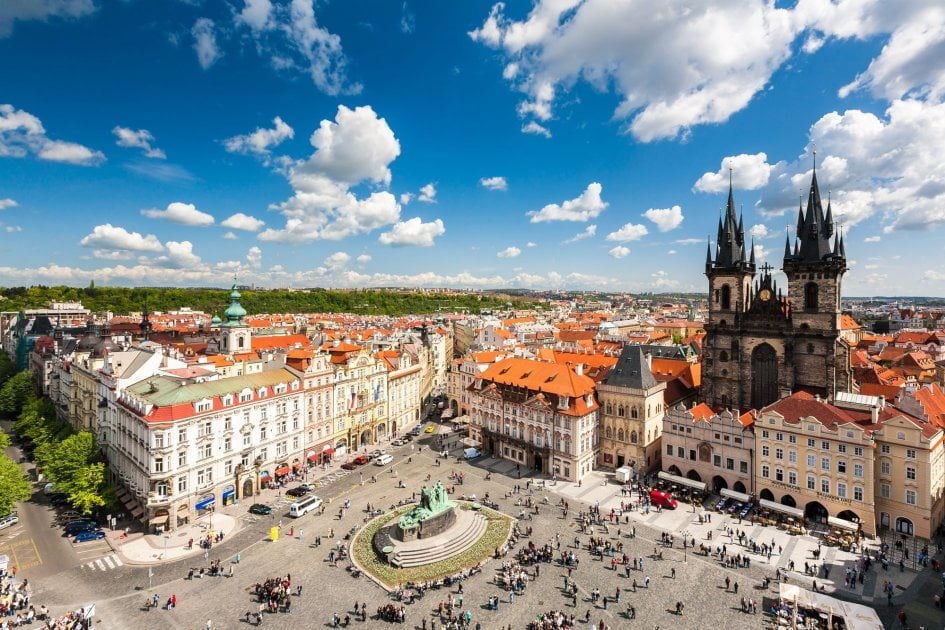The Czech capital, known as “Golden Prague,” is a city where the medieval atmosphere is particularly strong, as it has many architectural monuments from that era and entire districts that have almost entirely preserved their former appearance. Anyone who has visited this city even once is forever enchanted by it. Here is a suggested itinerary for seeing the best of Prague in 2 days on your own.
Day 1
To get a more complete picture of the Czech capital, it is best to start exploring from the place where beautiful Prague began.
Prague Castle
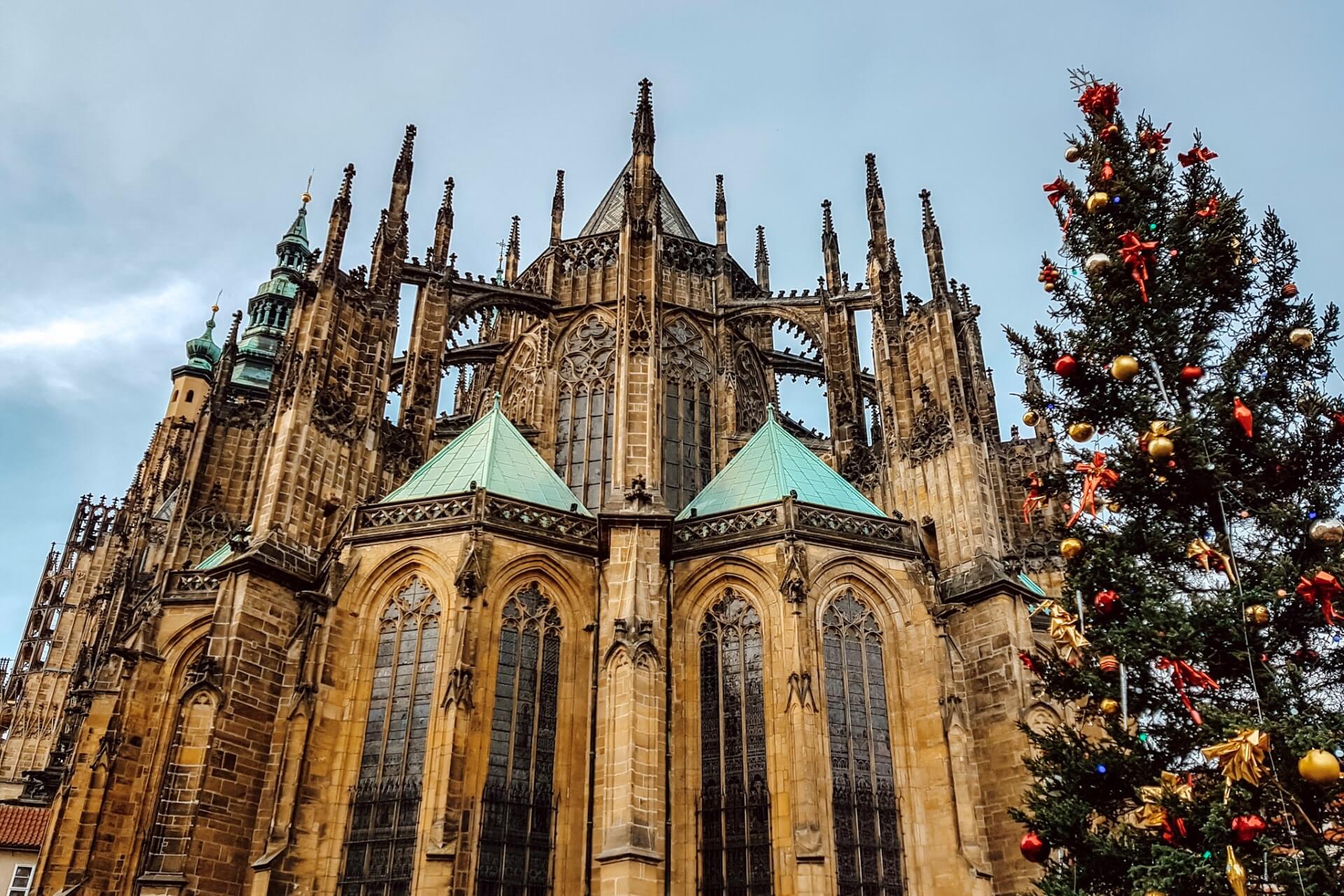
Spread out on the left bank of the Vltava River, this castle complex is the most grandiose old fortress (9th century), with the largest residence in the world listed in the Guinness Book of Records. Covering an area of 7 hectares, it houses 3 courtyards with many magnificent palaces and majestic churches from the past. The gates leading to the Honor Courtyard (1st courtyard) are a true work of art, adorned with elegant statues of titans.
In this courtyard, you can see luxurious Royal Halls, including the Throne Room and the Spanish Hall. The 2nd courtyard is famous for the Chapel of the Holy Cross, the Art Gallery with a rich collection of painting masterpieces, and the Imperial Stables. The third courtyard is home to the St. Vitus Cathedral (11th century), where Czech rulers were crowned and later buried.
Such an honor was also bestowed upon Prague archbishops. This magnificent architectural and religious monument of Gothic style continues to impress with its majestic halls, watchtowers, and unique decor. Passing through St. George’s Square, you will reach the Golden Lane – a charming authentic corner of the Middle Ages with tiny 16th-century houses.
According to legend, alchemists who turned stones into gold lived here. There is a wonderful toy museum and an exhibition hall in the former mayoral residence that are worth visiting.
Hradčany Square
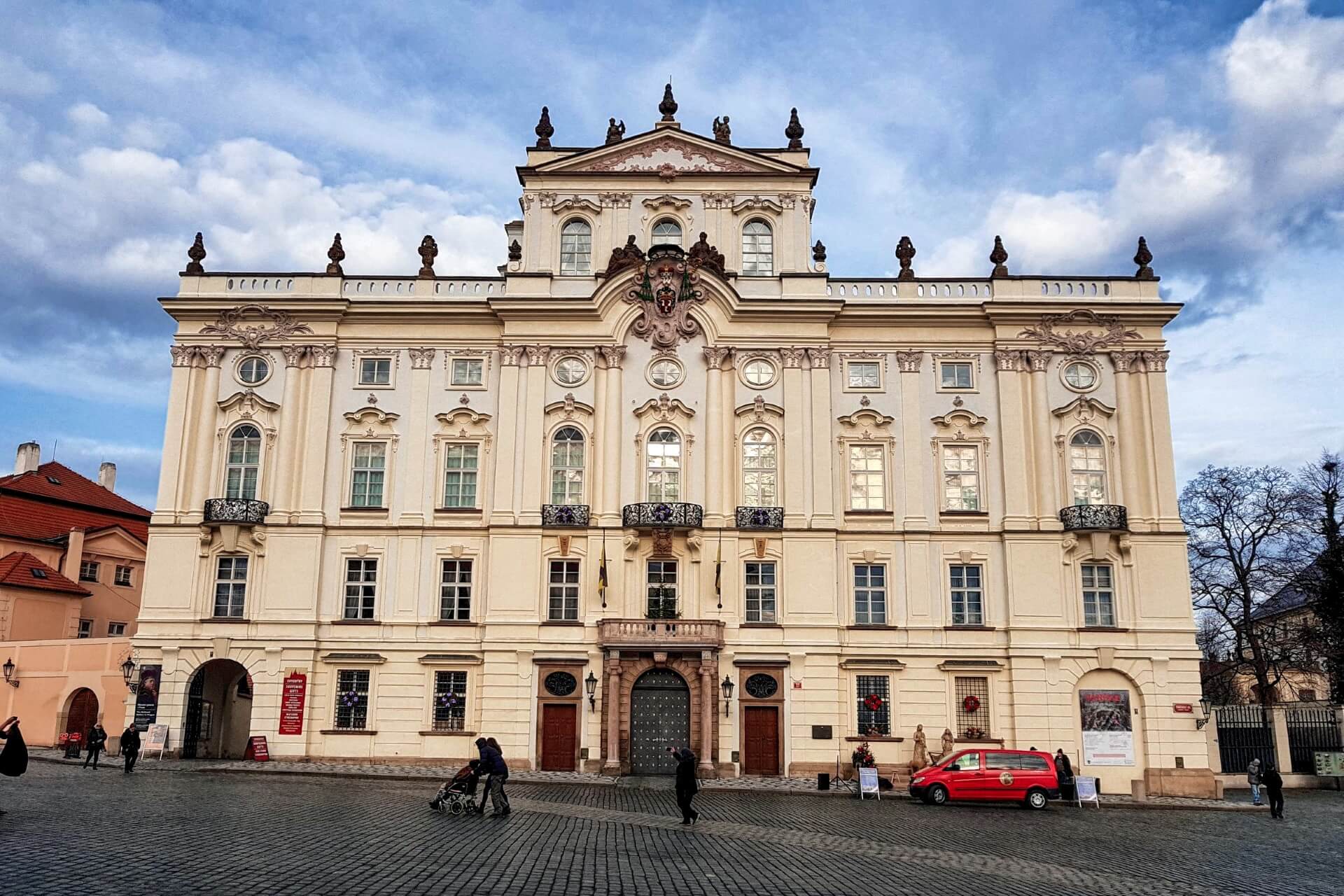
You cannot miss the famous Hradčany Square, which you can reach through the Western Gate of Prague Castle. You will be amazed by the beautiful palaces surrounding the square on all sides, the Plague Column with figures of apostles and a sculpture of the Virgin Mary, the green velvet lawns, and the dimensions of the old square.
The Salm Palace is named after its owner and founder, Wilhelm of Salm. Another owner, who bought the neoclassical building with Empire-style decorations, combined it with the neighboring building, creating a grand palace complex. It now houses an impressive exhibition of 19th-century art.
The Schwarzenberg Palace from the 16th century, with its Renaissance facade decorated in the sgraffito style, is a true decoration of the square. The interior is just as beautiful as the exterior. The original interior paintings have only been preserved on the 3rd floor.
The Tuscan Palace is an incredibly beautiful monument of classical Roman Baroque architecture, with its facade crowned by the family coats of arms of the Tuscan counts and the top of the building adorned with seven allegorical sculptures of the “liberal arts.” All six palaces with luxurious facades on the square will leave an indelible impression.
Petřín Lookout Tower
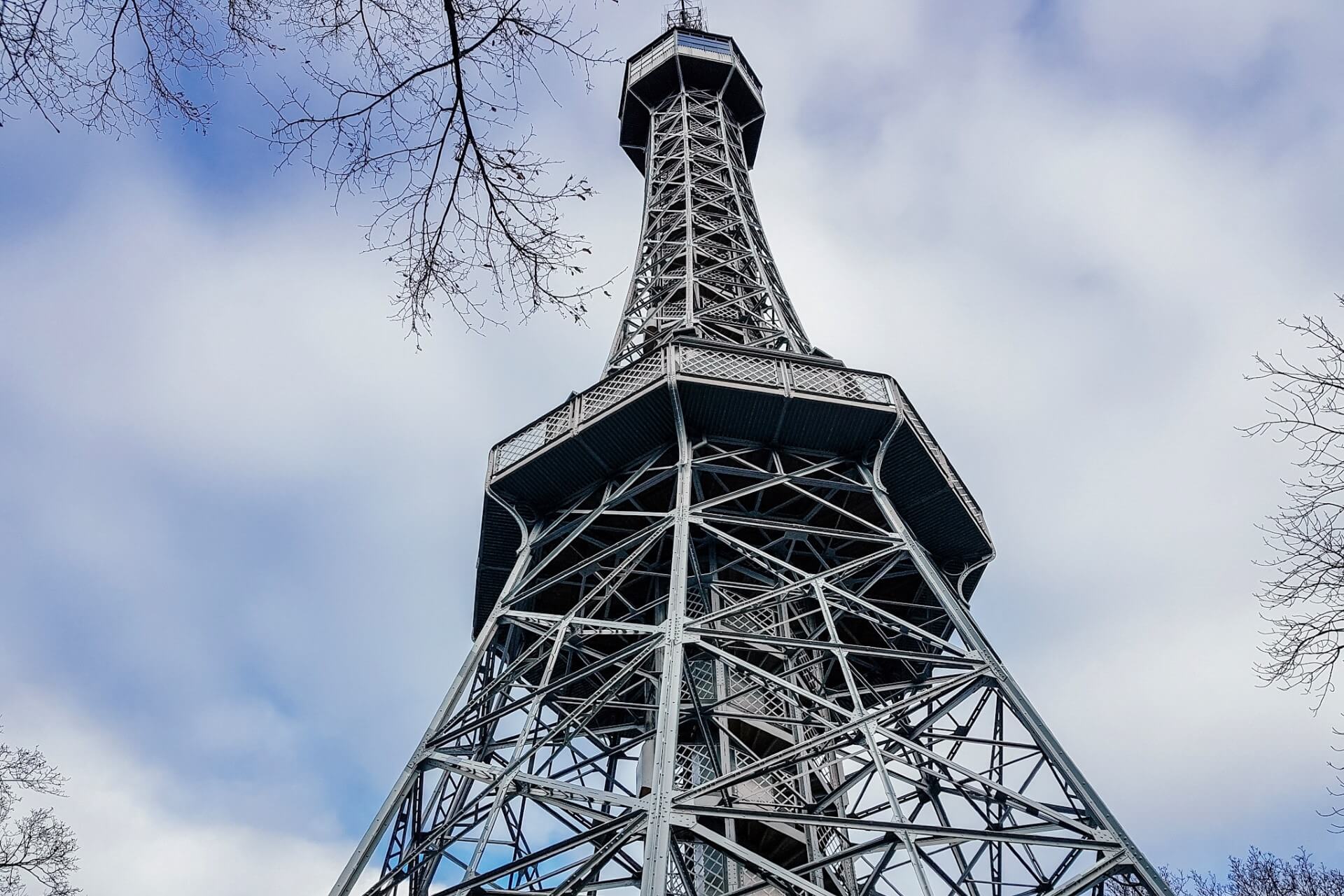
If you want to see the entire Czech capital at once, head to the observation deck of the famous Petřín Lookout Tower, built in 1891 for the International Exhibition. Inspired by the Eiffel Tower, its creators decided to create something similar in their city. The result is a scaled-down version of the Eiffel Tower located on Petřín Hill, reaching the same height (324 meters above sea level).
Among the intricate metal structures are two observation decks, the upper one located at a height of 55 meters. You can reach it by elevator (for 60 crowns) or by climbing 299 steps. From there, you can enjoy a panoramic view of the picturesque surroundings of Prague and its famous landmarks.
After descending to the 1st floor, you can relax in a small cozy café with a cup of tea or coffee, buy national souvenirs in a nearby shop, and visit a mini-museum dedicated to the popular Czech literary character Jan Cimrman. Entrance to the tower costs 120 crowns, with a reduced rate of 65 crowns for children and concessionary categories.
Nerudova Street

To further immerse yourself in the atmosphere of old Prague, you must visit Nerudova Street in the Malá Strana district. This street, with its preserved 15th-17th-century buildings, can be called an open-air museum, where almost every facade is a kind of architectural monument of different styles: Baroque, Renaissance, Gothic.
A characteristic feature of this medieval corner was the absence of house numbers – instead, family crests of the owners were displayed. Gothic arches, rare door handles, massive decorations, and unusually shaped locks impress the imagination and transport you to the distant past. You will be fascinated by the beautiful Renaissance-style house “At the Golden Cup,” where a famous jeweler once lived, marked by a golden cup symbol.
You’ll also be interested in the house “At the Two Suns,” where poet Jan Neruda lived and worked for 53 years, with a memorial plaque depicting a young man holding a shield with a Masonic sign. Other authentic buildings deserve attention.
For example, the “At the White Swan” – a palace mansion with a Baroque-style facade featuring a relief of a white swan above the door. Walking through the entire Nerudova Street to the Old Town Square, you will see the true Baroque architectural gem – the Church of St. Nicholas near the Town Hall.
Church of St. Nicholas
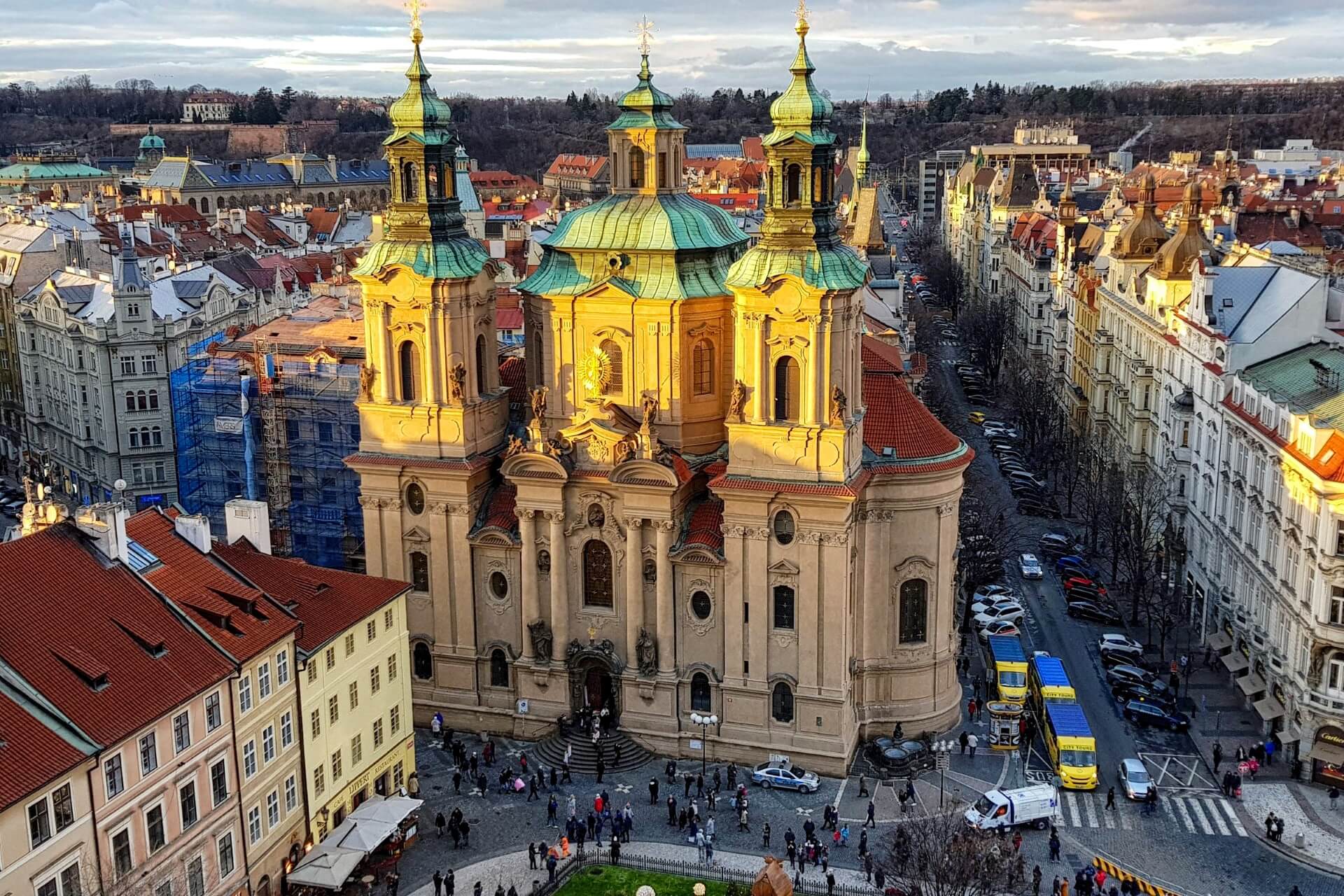
This magnificent domed cathedral, currently belonging to the Hussites, has a very complex and long history and is an unparalleled example of religious architecture. Built in the 17th century as a symbol of Catholicism, it has undergone numerous reconstructions, served as both an Orthodox and Catholic church, a grain warehouse, experienced years of neglect and ruin.
After the fall of the Austro-Hungarian Empire, the cathedral was given to the Orthodox community of the city, and its revival began with the participation of Orthodox churches from Europe and Russia. The restored church was consecrated on August 16, 1874 – the congregation was literally blinded by its external and internal beauty.
You can endlessly admire the magnificent Baroque decorations and statues of saints on the facade, beautiful frescoes on the interior vaults and altar, and the stunning chandelier in the shape of a royal crown (a gift from Alexander II). The church has unique acoustics, allowing for organ and classical music concerts to be held in it. It is known that during his visit to Prague, Wolfgang Amadeus Mozart played the organ in the church and praised its acoustics as perfect.
Having gained spiritual and aesthetic enrichment, it’s time to think about sustenance. If you don’t want to spend time on a full meal, you can snack on famous Prague “trdelniks” with coffee – sold everywhere in the square. A full Czech meal will be offered at any café in the nearby alleys. After refreshing yourself, walk with the crowd to the oldest bridge in Prague – Charles Bridge.
Charles Bridge
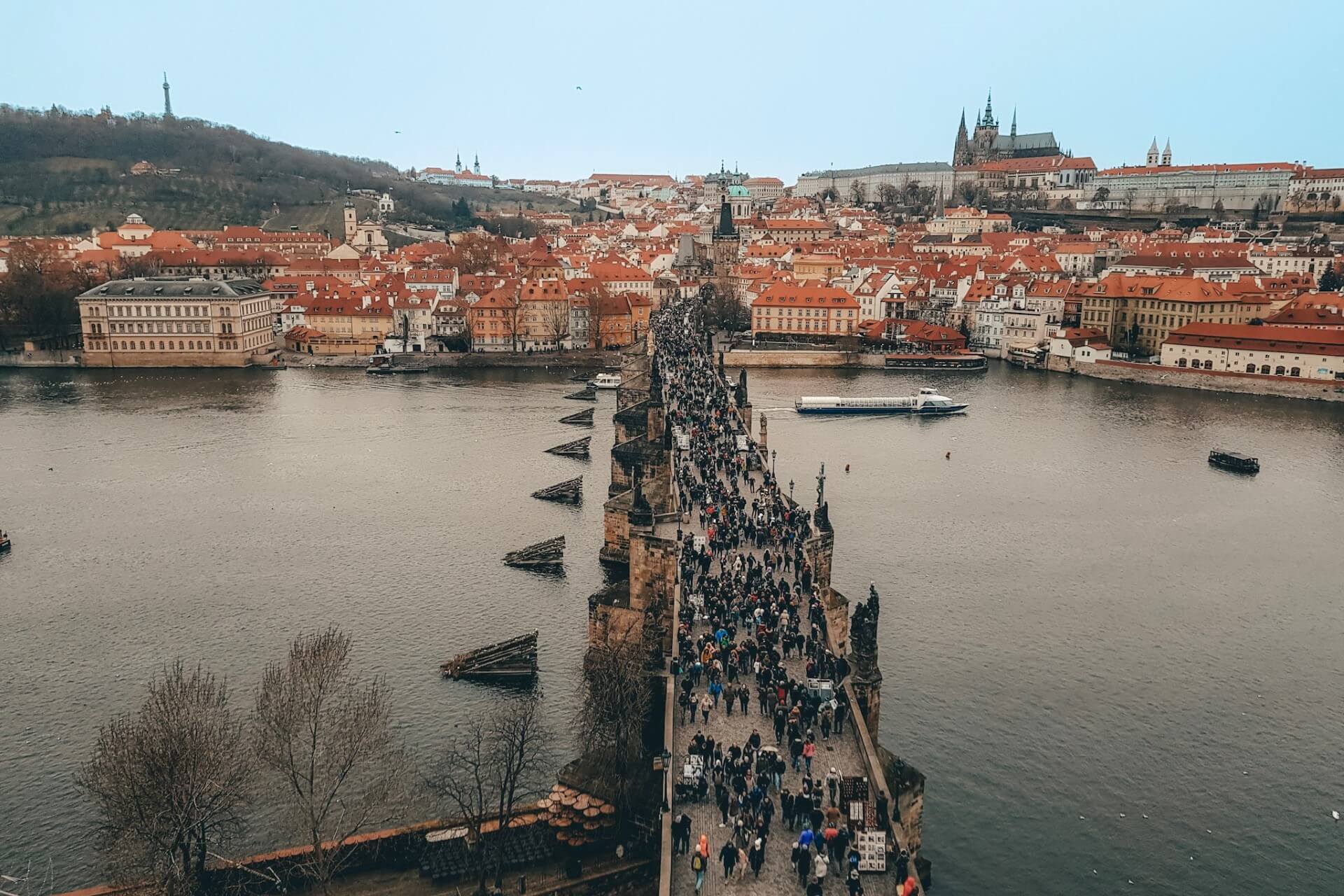
This is another medieval symbol, a grand marvel of bridge construction (516 meters long, 10 meters wide), a kind of open-air museum. The rich history of the bridge can be described at length, but the main thing is that it has stood since the 14th century, gradually being adorned with towers and sculptures (30 in total).
It is always crowded. Now Charles Bridge is pedestrian-only and is the main Prague attraction where creative people – musicians, artists, and artisans – gather year-round. Here, you can buy not only trinkets but also genuine works of art.
By examining the magnificent statues of Czech saints, you can visually acquaint yourself with the history of the national religion, see familiar and new names, and feel the spirit of unified Orthodoxy. A romantic legend is associated with the statue of the martyr St. John of Nepomuk, who was drowned in the Vltava River by order of the king. If you touch the base of the sculpture and make a wish, it will definitely come true – that’s the essence of the legend. You can test the result for yourself.
Old Town Square
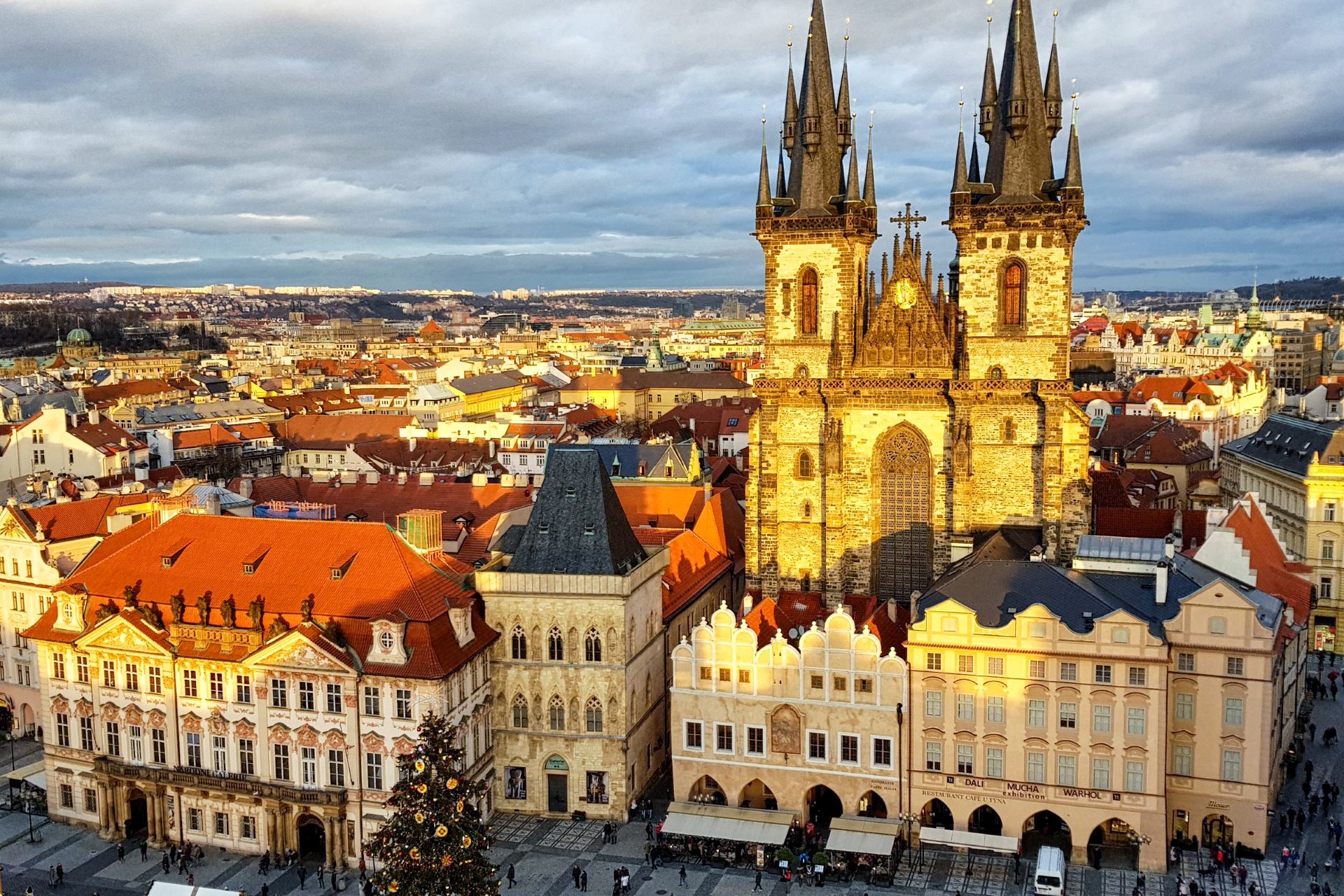
After crossing the bridge and enjoying all its beauties, you will reach the Old Town Square – the heart of the Old Town district. In its center stands a monument to the famous Hussite leader and national hero Jan Hus, erected in 1915 (500th anniversary of his execution). The sculptural masterpiece depicts Jan with his followers and emigrants forced to leave the country after the uprising’s defeat. The monument touches with its sculptures and the content of the phrases inscribed on the pedestal.
The Old Town Hall, with its 56-meter tower and astronomical clock, attracts undeniable interest. In the adjacent square, the names of 27 executed leaders of the Hussite uprising are engraved on the pavement. Visiting the Hussite Church of St. Nicholas (north side) will add positive emotions and strong impressions, as will visiting the Church of Our Lady before Týn, located in front of the Týn School.
You cannot pass by the magnificent Kinský Palace, where Nobel Prize laureate Bertha von Suttner was born and raised. All the buildings surrounding the square have interesting histories and are monuments of medieval architecture.
Powder Tower
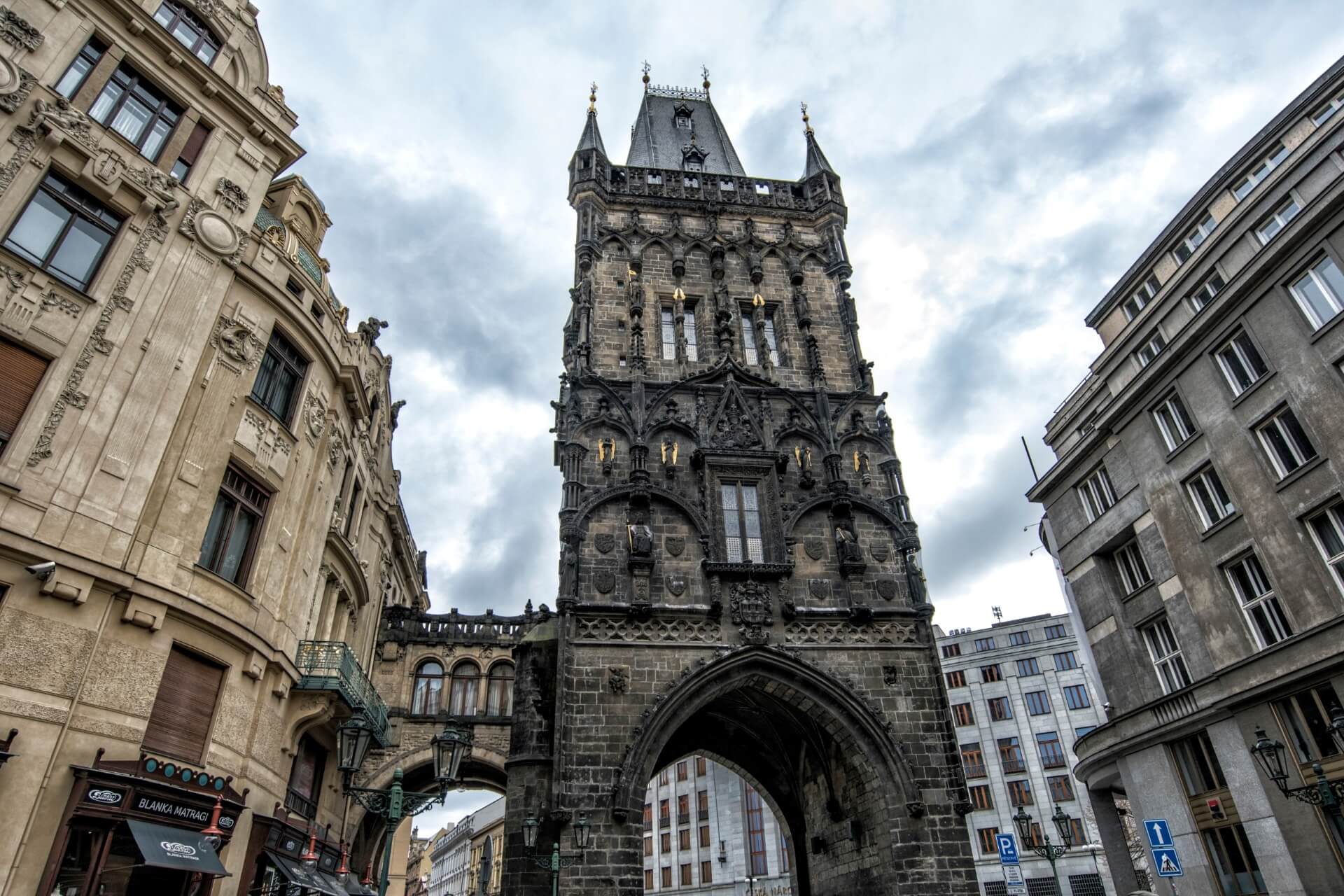
From the Old Town Square, the Powder Tower leads to the New Town, located on Republic Square. Construction of the tower began in the late 15th century, intended to be the 13th entrance to the Old Town, but it remained unfinished for a long time.
The tower, with its temporary roof, stored gunpowder, hence the name “Powder Tower” or “Powder Gate” – an architectural gem. In the 19th century, the tower was renovated in the Neo-Gothic style, removing all decorations and details that did not match the Gothic style.
You will undoubtedly be interested in the tower’s walls, adorned with sculptures of crowned heads, Czech saints, builders, guards, and angels – Prague’s history in faces. There are many interesting details: at the entrance to the Powder Tower stands a warrior in red, inviting you to enter, and inside are armor dummies for tourists to photograph. If you climb to the observation deck on the 2nd floor (186 spiral steps), you can enjoy an incomparable view of Prague from above.
Wenceslas Square

Walk from the Powder Tower through the Fruit Market (where you can try some fruit), past the Estates Theatre, and you will reach the main square of the New Town – Wenceslas Square. “Václavák,” as the locals call it, is more like a wide boulevard, starting with the equestrian statue of St. Wenceslas – a popular meeting and dating place.
The former horse market has turned into a place of bustling life day and night. An endless series of shop and restaurant signs, beer bars, crowds of tourists gazing at the numerous attractions. The neo-Renaissance building of the National Museum, with the statue of Wenceslas in front, immediately catches your eye. If time allows and you wish, you can enter to get at least a superficial idea of the exhibition’s scale.
The “Koruna” Palace building, now a shopping and office center, will interest you with its corner tower with a glowing crown and allegorical sculptures. The beautiful modern palaces “Europe” and “Astra,” the old “Ambassador” hotel building, the “Adam” pharmacy, the house of Peterka in the Prague Art Nouveau style, and other architectural monuments will be remembered for their extraordinary appearance.
To conclude the first day, you can enjoy dinner in one of the cozy cafes on the square if you don’t mind spending money. There are many budget eateries outside the square where you can find tasty and healthy food.
Day 2
The second day will be less intense but no less interesting and surprising, as you will see the places where Prague began.
Vyšehrad
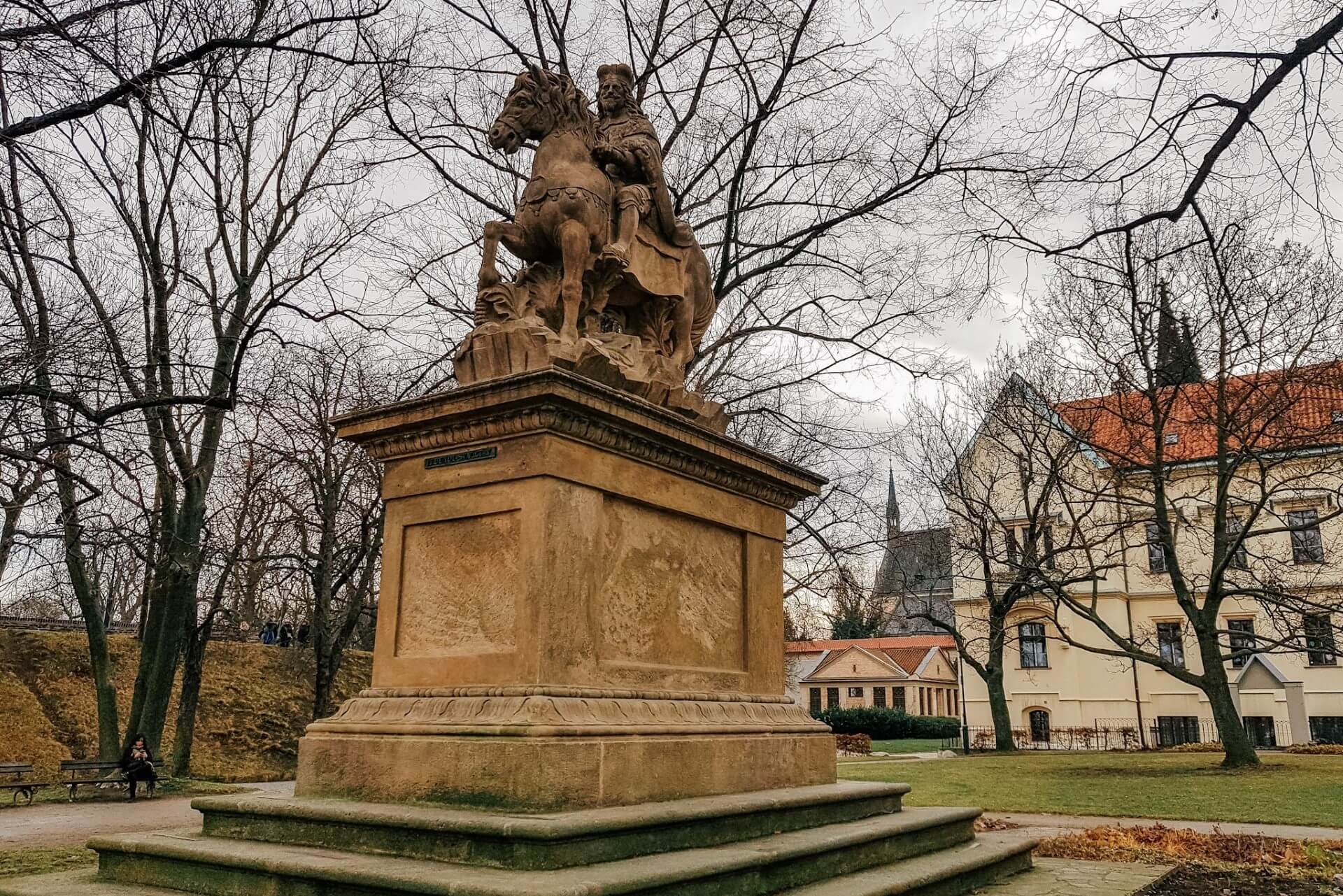
The legendary district of the Czech capital, located on a rocky hill by the Vltava River, Vyšehrad is filled with legends and fairy tales, growing from a fortress that emerged in the 10th century. Representatives of the first princely dynasty, including the famous Princess Libuše, settled here.
Subsequently, other noble families built their residences here, churches appeared, and Vyšehrad became both a royal residence and a symbol of Czech national history. Entering the Vyšehrad gates, you immediately realize that Vyšehrad is a concentration of architectural and historical monuments. You cannot miss the high towers of the Church of St. Peter and Paul, which impress with their well-preserved exterior and magnificent interior decoration.
The ancient Romanesque-style structure, the Rotunda of St. Martin (10th century), and the later Chapel of the Virgin Mary (18th century), in front of which stands the Plague Column in memory of the thousands who died from the plague, are also worth admiring. The seemingly unpretentious Devil’s Column will interest you with its many legends and beliefs about its origin.
The Vyšehrad casemates will astound you with their mysterious corridors and sculptural compositions, as will the Vyšehrad cemetery “Slavin” with the famous names of notable Czech figures.
Emmaus Monastery
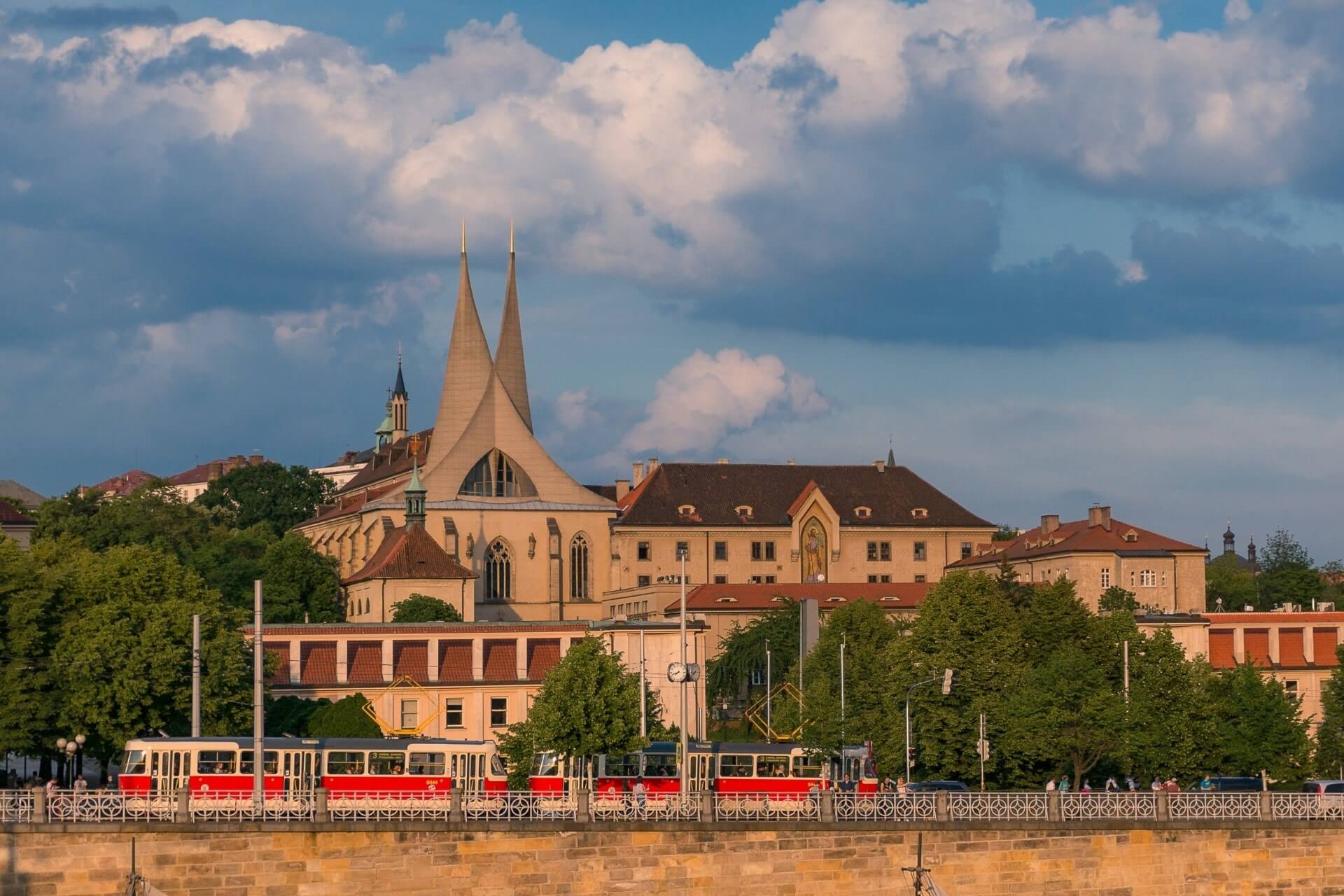
In the same district of Prague 2, you should definitely visit the Emmaus Monastery. The structure, with its modern spires sharply contrasting with other buildings, was founded by Charles IV as a male Benedictine monastery where Jesus, according to legend, preached to his disciples on the road to Emmaus.
The monastery’s purpose was to maintain the traditions of Cyril and Methodius and, in general, the Old Church Slavonic language, hence its second name, “Na Slovanech.” The space in front of the ancient monastery seems to be imbued with the atmosphere of Czech history and the special spiritual energy emanating from the Chapel of Saints Cosmas and Damian located at the entrance.
A visit to the Church of the Virgin Mary on Slovanech and the entire monastery will leave a deep impression. Here, you will see rare examples of Gothic painting – frescoes with biblical scenes introducing the congregation to the history of the Christian religion, and other rare artifacts. The Benedictine monastery continues to serve as a link between the two branches of Orthodox Christianity, which is especially important in our turbulent times.
Charles Square
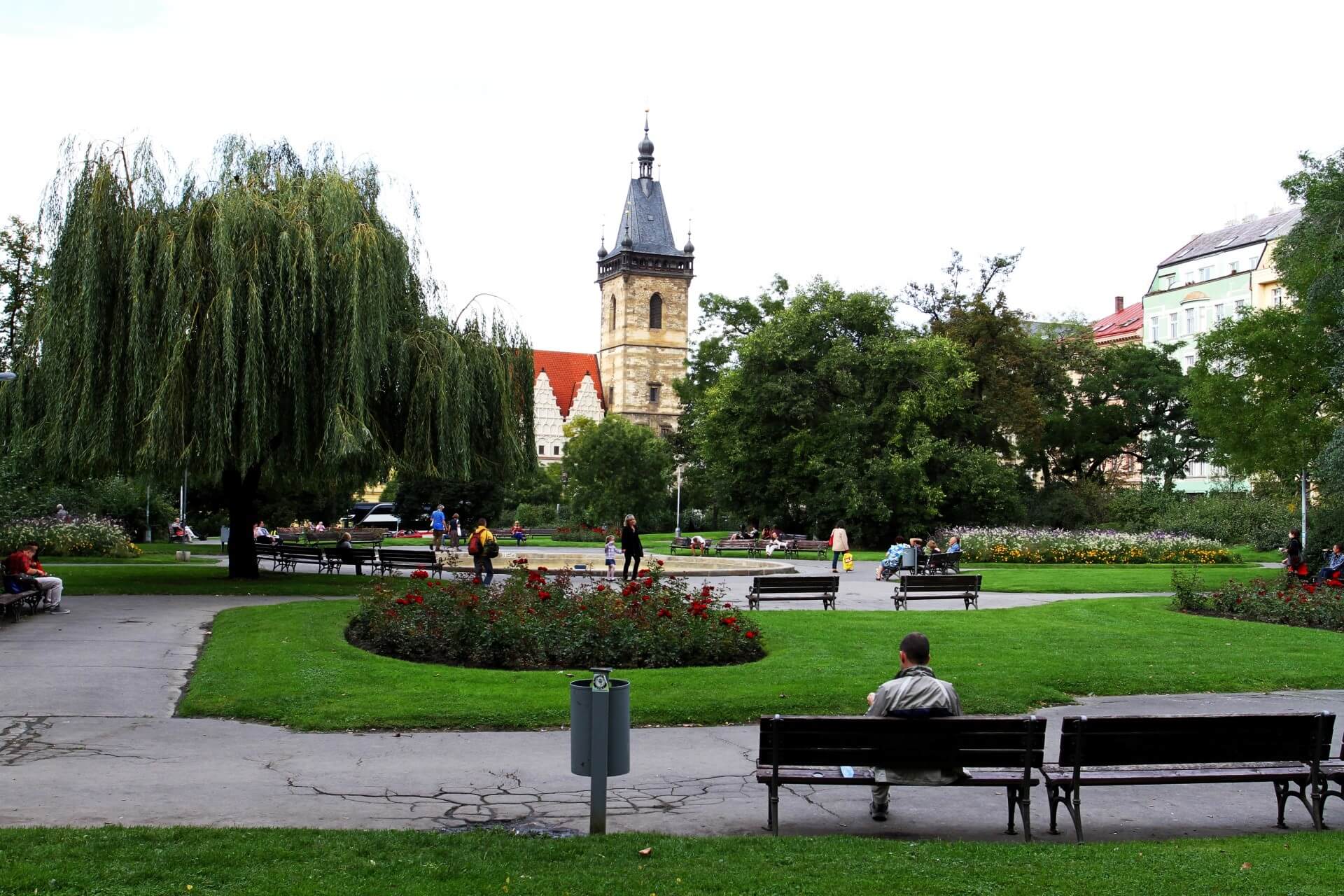
Continuing your walk through the New Town (Prague 2) district from the monastery, head to the largest (among 27) historical square, laid out by Charles IV in 1348 on the site of a market. Everyone who comes here is immediately charmed by the magnificent English-style park with beautiful monuments and sculptures, numerous historical and religious buildings on all sides of the square. You will see sculptural images of Czech poets and writers, public and political figures, and great scientists.
Everyone will be interested in the unusual monument in the form of a fountain with a Plague Column in the center, topped with a divine statue of St. Joseph. You won’t miss the original building of the Town Hall, facing the square with its central three-story wing. If you enter the 1st floor, you will find a Gothic-style hall where weddings take place today.
It would be unforgivable not to examine the famous Faust House, covered with a veil of mysterious mysticism, claiming that Goethe’s hero was sent to hell from here. The legends are based on the residence of alchemists, medics, and naturalists in the house.
Brewery House
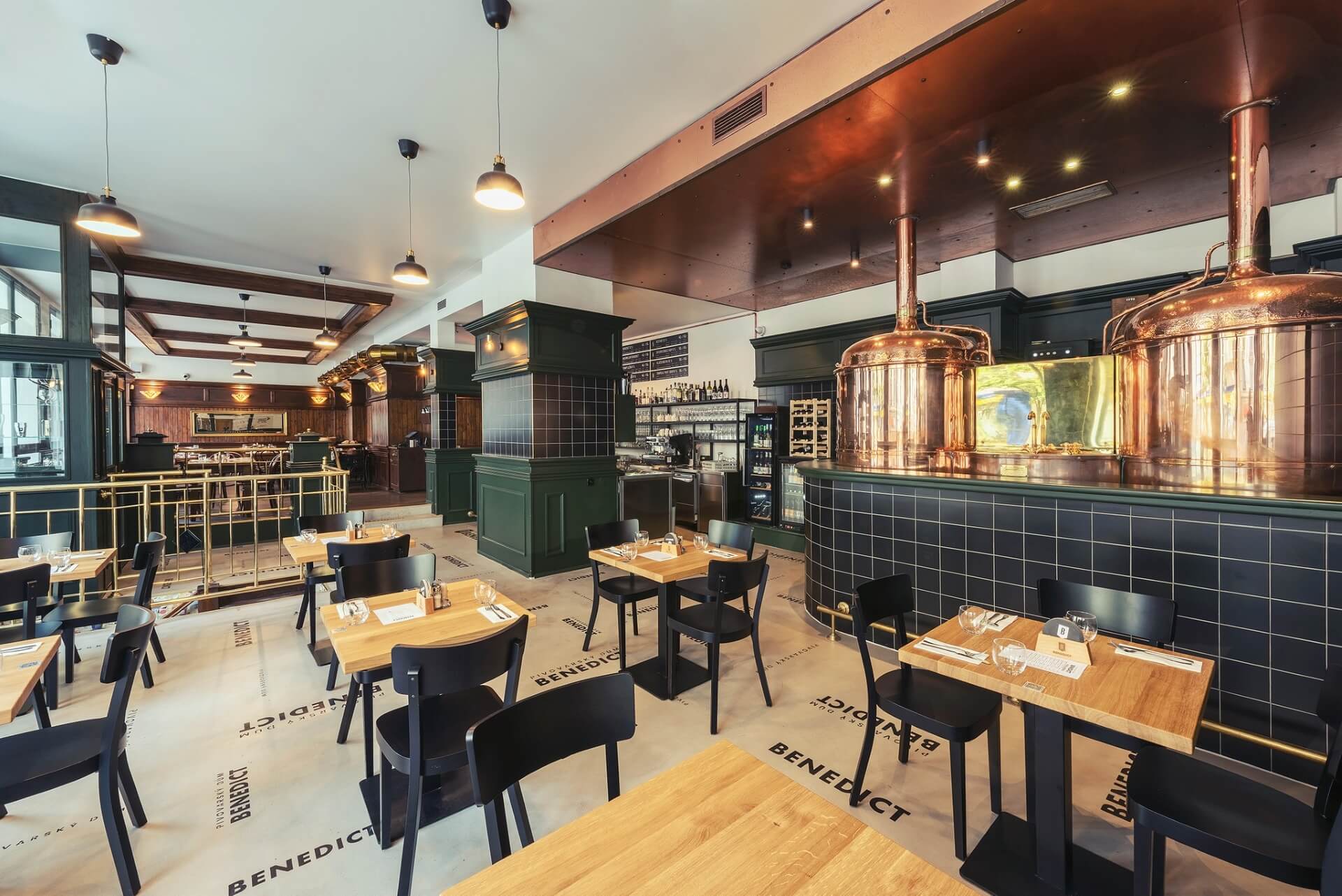
After acquainting yourself with Prague’s spiritual and cultural values, you can indulge in some earthly pleasures by tasting the world-famous Czech beer. For this, you should visit the “Brewery House” pub near Wenceslas Square, at the intersection of Ječná and Lipová streets.
Today, the solid seven-story building, constructed in place of the old house, belongs to a research institute. The microbrewery opened here on the 1st floor in the 1990s and gained incredible popularity among locals and tourists, becoming the best establishment of its kind. You will be amazed by the variety of beers, with the elite being Štěpán.
Here you can try dessert beers with banana, cherry, coffee flavors; champagne, cut, and even… nettle beer. All this will be served to you on a unique carousel – a wooden tray rotating eight glasses of different beers.
There is also a “carousel” with stronger drinks. The beer is accompanied by delicious national dishes and snacks, including the famous pork “knee.” You will spend unforgettable moments here, watching the brewing process and examining old artifacts.
Vltava Embankment
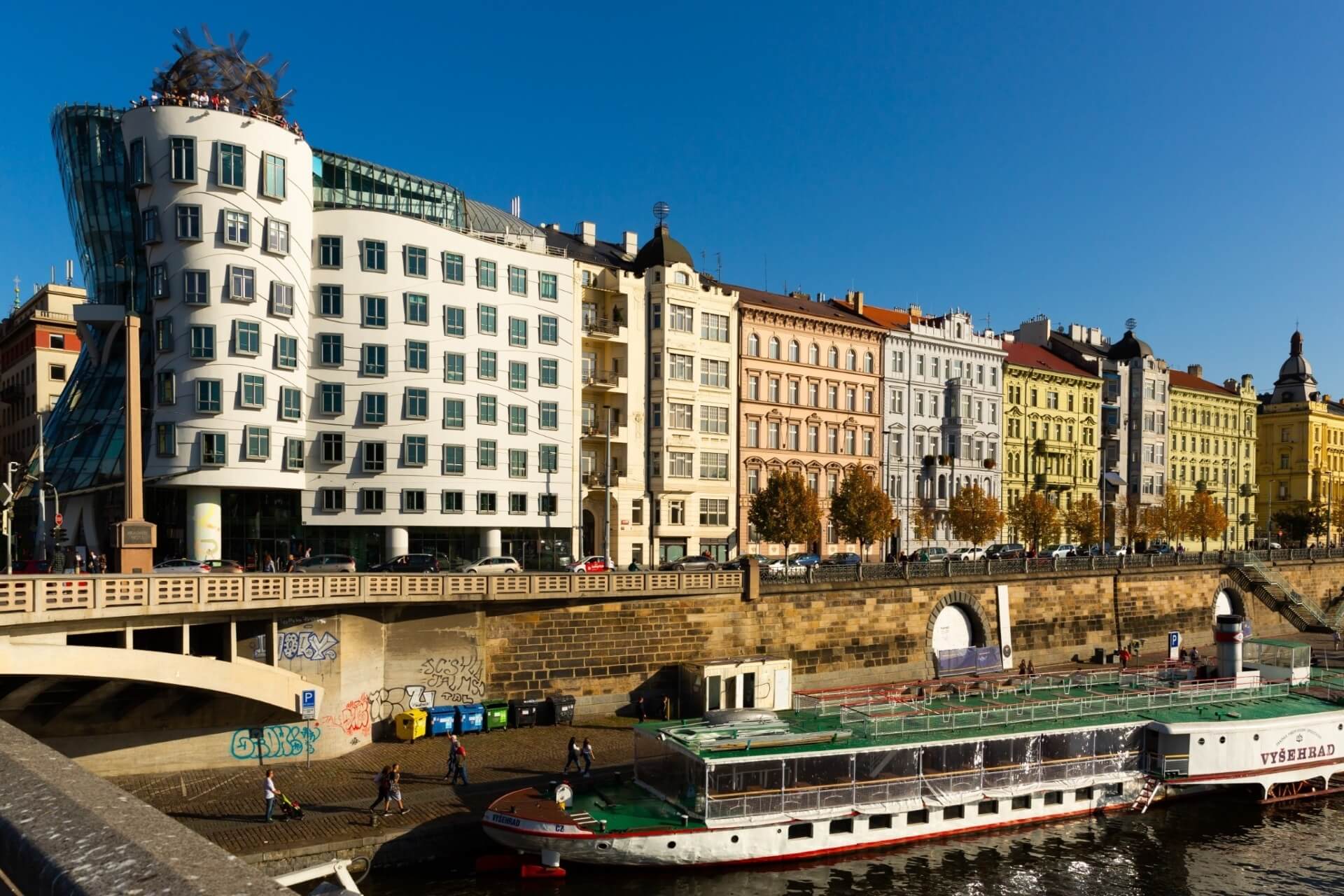
After a hearty dinner with beer tasting, the best thing to do is take a walk along the Vltava embankment, with stunningly beautiful views of old palaces and mansions reflecting in the river’s waters. It is impossible to “see all the embankments and all 18 bridges at once,” but you must see the architectural marvel – the “Dancing House,” located at the intersection of Resslova Street and the embankment.
This architectural masterpiece of deconstructivism from the 1990s, represented by two cylindrical towers, symbolizes a dancing couple. The metaphorical creation of Milunić and Gehry is popularly called “Ginger and Fred” (famous American dancers). On both sides of the Vltava, you will see significant historical buildings of Prague: Strahov Academy (government house), Rudolfinum (house of art), Klementinum, Church of St. Salvator, and many other interesting objects.
Jewish Quarter
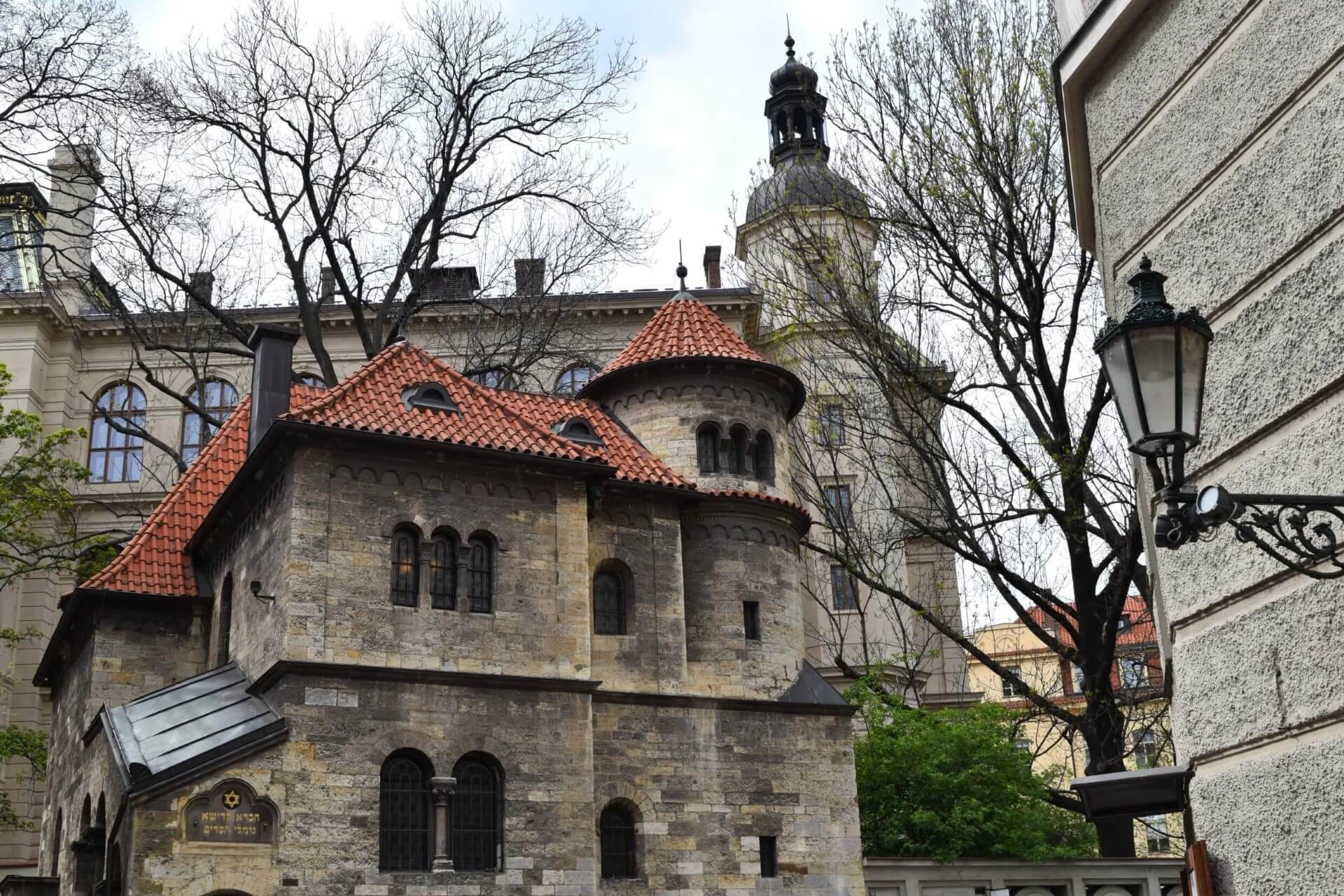
Turning from the embankment onto Paris Street, you will come to the “Josefov” or “Jewish Quarter,” founded in the 12th century by order of King Joseph. Turning from Paris Street onto Široká, you will reach the Spanish Synagogue, where a mystical-allegorical monument to writer and philosopher Kafka is installed at the entrance. The unusual image will attract your attention, make you think, and search your memory for what you know about this figure.
The beautiful synagogue building in the Moorish style itself is also interesting, and its interior dazzles with the brilliance of gold decorations, the brightness of enamel, the beauty of stucco, and the intricacy of patterns. There is also the functioning Old-New Synagogue, symbolized by the mythical clay figure Golem supposedly animated by Rabbi Löw.
Interesting objects include the Jewish Town Hall, the High and Pinkas Synagogues, and the Old Jewish Cemetery, where the expressive “Holocaust Victims Memorial” is located. On your way out of the cemetery, you will see the luxurious building of the Maisel Synagogue, and then you can visit the “U Golema” restaurant to not only replenish your strength with delicious food but also see the autographs of famous visitors on the walls.
Prague can be explored for months and years, but what you see in 2 days will give you a comprehensive idea of this amazing fairy-tale city, a city-museum.

